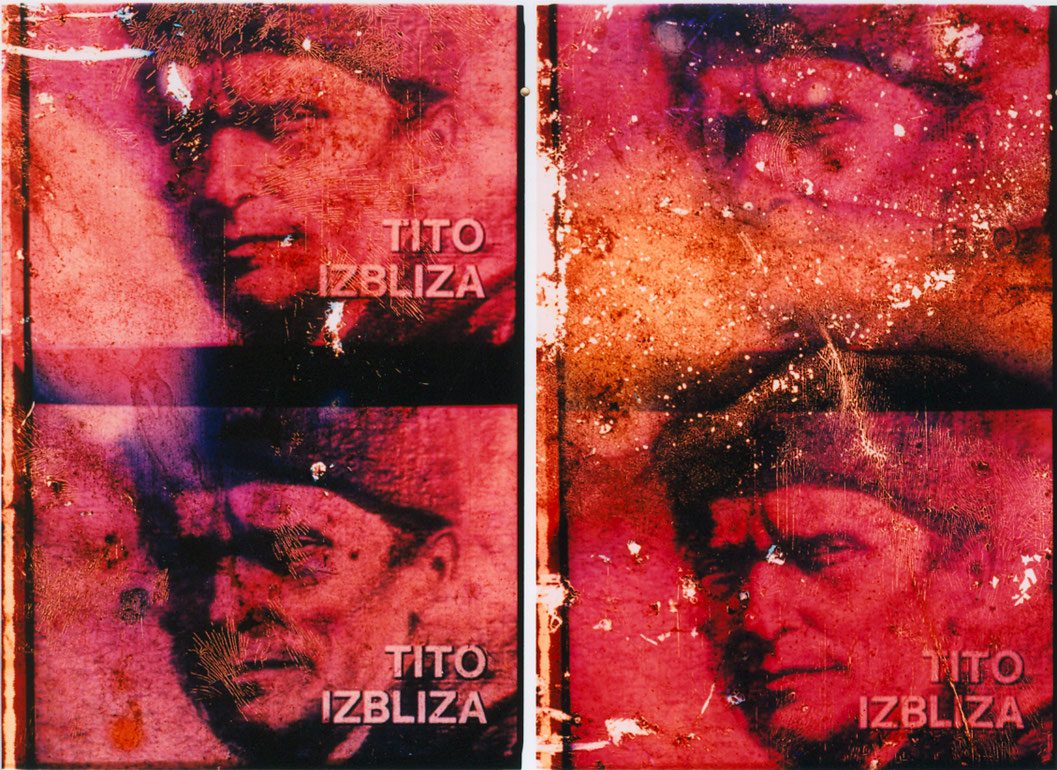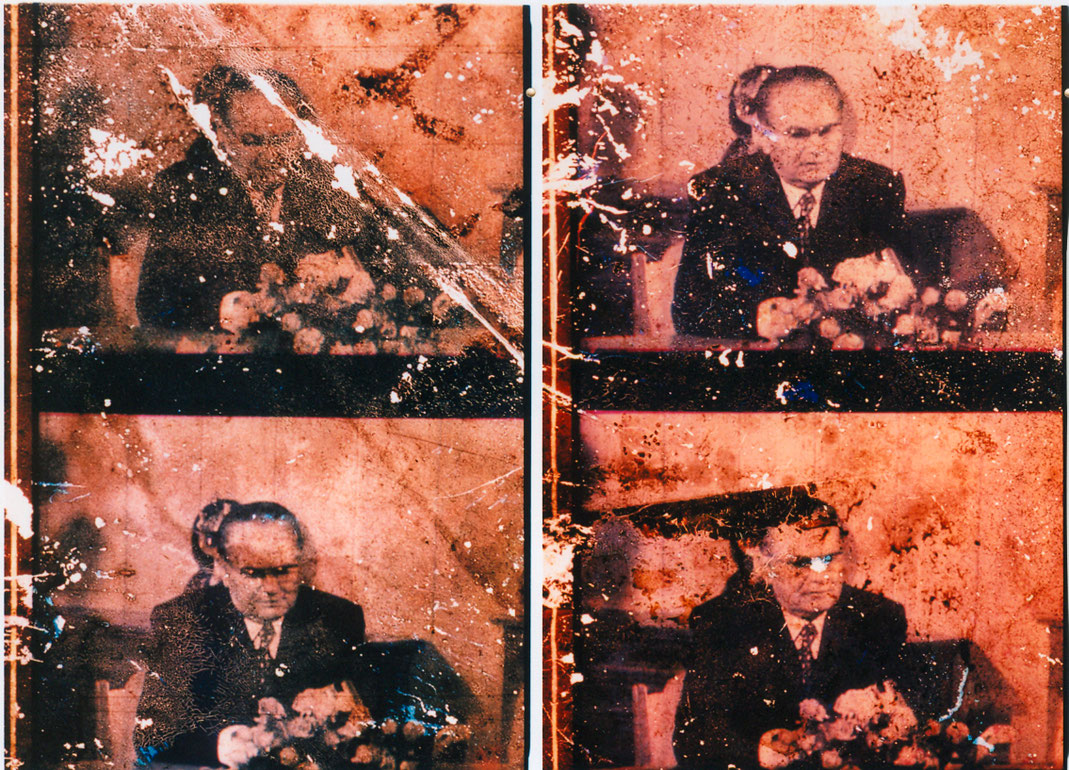Tito-Material
Gefundenes Material: Filmbilder, die Tito in verschiedenen Kontexten zeigen, bei öffentlichen Auftritten, bei den Partisanen, "privat" beim Rasieren usw. Fundort: ein zerstörtes Kino in Mostar 1996. Aber die auf der optischen Bank entstandene Filmkonstruktion ist natürlich immer auch ein Gegenentwurf zu den anderen eher narrativen Modellen: die Spuren des Krieges sind nicht primär auf der Ebene der Repräsentation erfahrbar, sondern an der Beschädigung durch Schutt, Feuchtigkeit, am Material selbst und seiner Bearbeitung.
(Birgit Flos)
Die Filmemacherin Elke Groen hat aus einem im Krieg zerstörten Kino in Mostar einen Film geborgen, ein Fund, der aus vielen bunten Bruchstücken besteht, an den Streifen klebt der Staub, sie sind spröde, geknickt, verdrückt, die Perforation ist stellenweise ausgebrochen – ganz abgesehen von den Schäden, Flecken und Kratzern in der Beschichtung. Nach viel manueller Kleinarbeit werden die verwitterten Bilder übertragen in einen neuen Film mit neuen Schichten: In Tito-Material, der gewissermaßen ein (Film-)Archiv ist, wird vielfältige Materie aufgehoben (ein Filmbild von einem staubigen Filmbild).
Er erzählt zugleich seine Geschichte, eine Begegnung oder eine Auseinandersetzung und er changiert zwischen den Zeiten und Ebenen: Hinten steht Tito, vorne ziehen die feinen Schlieren in einem eigenen Plan übers Bild. Der Fund ist zur Betrachtung aus neuer Perspektive freigegeben. Die Farben leuchten in fremder Tönung und natürlich haftet an derlei Beschäftigung mit Vorgefundenem, Vorgefertigten der Vorwurf romantischer Liebhaberei. Tatsächlich aber haben die filmenden Archäologen, angezogen und angerührt von Bildern und Bildträgermaterialien, die fast schon historische sind, ihre Arbeit an der Filmgeschichtsschreibung aufgenommen.
(Isabella Reicher)
Thomas Korschil about Tito-Material
Tito from close up and dated from around 1978. The weathered film, riddled with traces of time and history
shows Tito at public events, together with partisans and "in private". The material is in the process of
decay. Holes gapes through the emulsion. Some passages have become completely abstract and only consist
of shapes and colours. Groen investigated this strip of film, felt its scuffs, tears and folds and
photographed the fluctuating colours as well as the accumulated dirt. She doesn't force the fragment
into a unified structure, but instead tries various things out as she goes along. She notes details,
enlarges parts of the images (and thus, also, the grain). She lays down short loops, makes the pictures
flicker, has them hesitate or even come to a stand still. She reacts to the origins and historical
context of the piece cautiously. She notes things and comments events that can only be touched on
indirectly in this film. The context is inherently emotionally charges, the beauty of the dissolving
pictures sometimes over-powering. The original source was apparently a propaganda film of a system now
consigned to the history books, and it made extensive use of pictures from the Second World War. Groen's
selection of material uses these images very sparingly. Her film hints at things, no more and no less.
Thomas Korschil
Thomas Korschil zu Tito-Material dt
hautnah überschriebenen Films (zirca 1978). Die verwitterten, mit Spuren von Zeit und Geschichte
übersäten Stückchen zeigen Tito bei öffentlichen Auftritten, bei den Partisanen und "privat". Das
Material befindet sich in Auflösung. Löcher klaffen in der Emulsion. Manche Passagen sind völlig
abstrakt geworden, sind nur mehr Farbe und Form. Diese Streifen untersucht Groen, tastet ihre Schrammen,
Risse und Falten ab, fotografiert
die fluktuierenden Farben und auch den akkumulierten Schmutz. Dabei zwingt sie die Fragmente nicht
in eine durchgängige Struktur, sondern probiert verschiedenes aus in ihrer übertragung. Sie geht
ins Detail, vergrößert Bildausschnitte und damit auch das Korn. Sie legt kurze Schleifen, bringt
Bilder ins Flackern und ebenso ins Stocken oder zum Stillstand. Mit Herkunft und geschichtlichem
Kontext des Materials versucht Groen behutsam umzugehen. Sie macht Notizen, Anmerkungen zu
Ereignissen, die in diesem Film nur indirekt zur Sprache kommen können. Die Bezüge sind von
vornherein aufgeladen, die Schönheit der sich auflösenden Bilder manchmal überwältigend. Die
ursprüngliche Quelle war ein offenbar propagandistischer Film eines mittlerweile untergegangen
Systems, der sich in seiner Erzählung massiv an Bildern des Zweiten Weltkrieges bedient hat.
Groen verwendet diese in ihrer Auswahl nur sehr sparsam. Ihr Film will andeuten, nicht mehr und
nicht weniger.
Thomas Korschil
Seven Instances of the Austrian Avant-Garde, by Ed Halter
Imagine this tale as a parable of the distinctive paradoxes of avant-garde cinema. Exceedingly erudite conceptual structures and complex aesthetic systems achieve realization through collisions of light and sound, designed to throw the viewer into a confrontation with the barest elements of cinematic form, made possible with the slightly antiquated products of 19th century science. The formalist edge of Austrian filmmaking has always pushed such extremesmachine flatness and spiritual emotion, animal shock and cognitive puzzle, fleshy materialism and ghostly mystery.
Austrias success in fostering such a powerful experimental film scene is well known among cineastes worldwide. A conflux of generative factors can be cited: the storied history of avant-garde art and literature in Vienna; the influence of filmmakers such as Valie Export, Peter Kubelka and Kurt Kren, who attained international renown decades ago; the success of shorts distributor sixpackfilm, which has helped keep Austrian artists prominent in international festivals; and, not least, the long-standing commitment of governmental organizations such as Film Division of the Department of the Arts to fund such adventurous, non-narrative films. Dynamite doesnt come cheaply.
Look at a sample seven titles underwritten by the Film Division, and the impact of this sustained support will be made clear.
1. Kurt Kren, 49/95 Tausendjahrekino (1995)
There is a discernable sensibility to Austrian experimentsa cluster of threads that run through many of finest examples of filmmaking. Commissioned to mark the cinemas centenary, Krens Tausendjahrekinoopens with a title screen speckled with black bits of dust and detritus, then volleys through staccato flashes of tourists pointing cameras up at the St Stephens Cathedral in Vienna. Each of their banal snaps is countered by Krens guerrilla anthropology, captured with his shaking, zooming lens. Like this one, the best Austrian films are short, brutal and dirty.
2. Martin Arnold, Alone. Life Wastes Andy Hardy (1998)
Arnold takes Judy Garland and Mickey Rooney, two icons of innocent 1930s Americana, then stretches and remixes their language and body movements into a minuet of robotic jitters and beastly bleats, uncovering an uneasy sexual tension in the triangle of girl, boy and mother. The filmmaker digs deeps, hits nerves.
3. Elke Groen, Tito-Material (1998)
From the rubble of a decimated cinema in Bosnia and Herzogovina, Groen found propaganda newsreel footage of Yugoslavian President-for-Life Tito. Reprinted, Tito moves silently under layers of decay. Peter Gidal once defined materialist cinema as trafficking in that space of tension between materialist flatness, grain, light, movement, and the supposed reality that is represented. To this Tito-Materialadds the tension between past and present, state-sponsored fantasy and political reality.
4. Gustav Deutsch, Film Ist. (1998/2002)
The past becomes an ever stranger land in Film Ist. , filled with disjunctive colonialist mansions, supernatural religious footage, and accidentally surrealist science documentaries, all snatched from the era of silent cinema. These fragments are slowed down, re-cut and set to staticky electronic soundscapes. The flicker and hum evoke a hypnotic state: revisiting times lost as a form of disembodied dreaming. The soundtrack itself presages the experiments in digital, visual glitch seen in a more recent generation of Austrian video art.
5. Siegfried A. Fruhauf, Exposed (2001)
White oblong shapes float like clouds across one another, sailing across an expanse of movie-screen blackness, each glowing box in the round-cornered shape of a 16mm sprocket hole. One again a spirit is summoned from the very materials of the machine.
5. Kerstin Cmelka, Camera (2002)
In Cmelkas earlier films, Mit Mir and Et In Arcadia Ego, the filmmaker plays with her own doppelgangers, superimposing herself upon herself multiple times. Camera uses similar optical tricks to print moving images of woodlands on the interior walls of a small room. Recall that camera merely means room or chamber in Latin: so is the film camera offer a window on the world, or merely in illusion of one? Maybe we cant really leave the roomor cameraafter all.
7. Peter Tscherkassky, Instructions for a Light and Sound Machine (2005)
American critics blithely assume that films from outside our borders always comment on our own cultureas if the worlds artistic output had the mere function of an elaborate vanity mirror for us (So, tell me honestly, how do I look?). But here such a claim does not feel like this kind of indulgence. Tscherkassky takes moments from The Good, The Bad and the Ugly and handprints them into a rat-a-tat-tat wartime montage. The throb of exploding bullets reminds us of the clacking of the projector over our heads: the reflection throws us out of the theater and back into the world.
* * *
Certainly not every nation that has chosen to invest its capital into filmmaking has been as fortunate as Austria with the cultural returns. In many other nations, governmental financing and grant foundations make the mistake underwriting the bland and inoffensive. The strategy in Austria seems to have been to support the strongest elements of the idiosyncratic and rebellious fringe, to encourage daringly noncommercial work, and to strive for art, rather than mere entertainment.
Look at key words from these seven titles: kino, waste, material, film, exposed, camera, light and sound machine. Austrian experimental cinema always returns to contemplate its own being, but in doing so, seeks new engagement with the world.
Tito-Material
1998
Österreich
5 min


